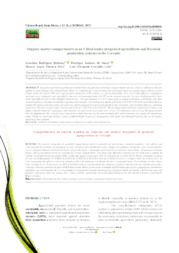Organic matter compartments in an Ultisol under integrated agricultural and livestock production systems in the Cerrado.
Organic matter compartments in an Ultisol under integrated agricultural and livestock production systems in the Cerrado.
Autoria: BARBOSA, L. R.; SOUZA, H. A. de; TEIXEIRA NETO, M. L.; LEITE, L. F. C.
Resumo: Integrated agricultural production systems have the potential to increase organic matter content, which is reflected in the soil carbon (C) and nitrogen (N) concentrations. Here, we evaluated the C and N stocks and its compartments in a typical distro cohesive yellow Ultisol under the no-till (NT) and crop-livestock integration (CLI) systems, in eastern Maranhão. Five areas with different management strategies were evaluated, more specifically, one area was managed under the NT system in succession for 14 years (soybean/millet), three areas had different CLI system adoption histories (i.e., CLI was adopted 2, 4, or 8 years prior to sample collection); and finally, one area consisted of native Cerrado (savannah) vegetation. Soil samples were collected at depths of 0-0.10, 0.10-0.20, 0.20-0.30, and 0.30-0.50 m,to analyze the content and total stocks of carbon (C) and its compartments (physical and chemical), N content, soil microbial biomass, and basal respiration. Results revealed higher content and stock of C and N in areas with CLI. The principal humic substance reported was humin, and higher concentrations of C associated with minerals were present in areas under more recent CLI adoption (2 and 4 years). We demonstrated that the adoption of CLI, even if recent, leads to immediate increases in the concentrations of C and its fractions as a result of using forage crops. NT for 14 years and CLI for 8 years exhibited higher levels of C management and higher soil biological activity due to the greater stability of these systems.
Ano de publicação: 2022
Tipo de publicação: Artigo de periódico
Unidade: Embrapa Meio-Norte
Palavras-chave: Fracionamento do carbono, Integração lavoura-pecuária, Manejo conservacionista
Observações
1 - Por padrão são exibidas publicações dos últimos 20 anos. Para encontrar publicações mais antigas, configure o filtro ano de publicação, colocando o ano a partir do qual você deseja encontrar publicações. O filtro está na coluna da esquerda na busca acima.
2 - Para ler algumas publicações da Embrapa (apenas as que estão em formato ePub), é necessário ter, no celular ou computador, um desses softwares gratuitos. Sistemas Android: Google Play Livros; IOS: iBooks; Windows e Linux: software Calibre.
Acesse outras publicações
Acesse a Base de Dados da Pesquisa Agropecuária (BDPA) para consultar o acervo completo das bibliotecas da Embrapa.

